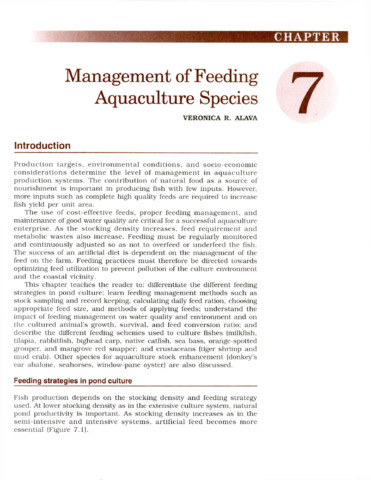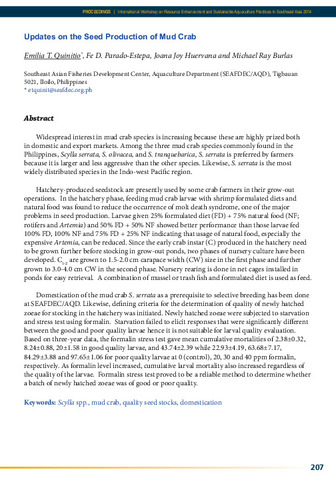Nursery culture of mud crab Scylla serrata fed diets supplemented with trytophan at two stocking densities
- Global styles
- MLA
- Vancouver
- Elsevier - Harvard
- APA
- Help

Date
2017Page views
52,361ASFA keyword
AGROVOC keyword
Taxonomic term
Metadata
Show full item record
Share
Abstract
Cannibalism has been recognized as one of the major problems in crab culture. The use of dietary tryptophan (TRP) that has been reported to reduce cannibalism in crabs under laboratory conditions was verified in pond nursery culture at two stocking densities. The first phase used hatchery-produced early crab instar. After 3-4 weeks, survivors were sorted and the small size crabs were further reared in the second phase. Crabs were stocked in 12-m2 net cages installed in brackishwater pond and fed three times daily at 0830, 1300 and 1630 h. The feeding scheme used was a combination of mussel meat (M) and formulated diet (FD) at 30:70 ratio. The original FD contained 45% crude protein (used in Experiment 1, 2 and 3) that was lowered to 40% crude protein in the new basal diet used in the succeeding experiment. The two TRP-supplemented diets had 0.5% and 0.7% TRP levels. Results showed that the TRP-supplemented feeds did not give consistent results in terms of growth and feed conversion ratio, indicating that the original basal diet (0.4% TRP and 45% crude protein) or the new basal diet (0.4% TRP and 40% crude protein) were sufficient to be used together with mussel meat as feed for crab juveniles. Higher survival rates were obtained at 50 m-2 (phase 1) and 10 m-2 (phase 2) than at 30 m-2 and 5 m-2 stocking density, respectively. All trial runs produced positive returns on investment.
Description
Abstract only.
Suggested Citation
Alava, V. R., Lucero, M. A., Sumile, J. D., & Parado-Estepa, F. D. (2017). Nursery culture of mud crab Scylla serrata fed diets supplemented with trytophan at two stocking densities. In E. T. Quinitio, F. D. Parado-Estepa, & R. M. Coloso (Eds.), Philippines : In the forefront of the mud crab industry development : proceedings of the 1st National Mud Crab Congress, 16-18 November 2015, Iloilo City, Philippines (p. 147). Tigbauan, Iloilo, Philippines: Aquaculture Department, Southeast Asian Fisheries Development Center.
Type
Conference paperISBN
9789719931072Collections
Related items
Showing items related by title, author, creator and subject.
-
Management of feeding aquaculture species
Alava, Veronica R. (Aquaculture Department, Southeast Asian Fisheries Development Center, 2002)This chapter teaches the reader to: differentiate the different feeding strategies in pond culture; learn feeding management methods such as stock sampling and record keeping, calculating daily feed ration, choosing ... -
Updates on the seed production of mud crab
Quinitio, Emilia T. ; Parado-Estepa, Fe D.; Huervana, Joana Joy; Burlas, Michael Ray (Aquaculture Department, Southeast Asian Fisheries Development Center, 2015)
Widespread interest in mud crab species is increasing because these are highly prized both in domestic and export markets. Among the three mud crab species commonly found in the Philippines, Scylla serrata, S. olivacea, ...
; Parado-Estepa, Fe D.; Huervana, Joana Joy; Burlas, Michael Ray (Aquaculture Department, Southeast Asian Fisheries Development Center, 2015)
Widespread interest in mud crab species is increasing because these are highly prized both in domestic and export markets. Among the three mud crab species commonly found in the Philippines, Scylla serrata, S. olivacea, ... -
European Union's special project on mudcrab
Castaños, Milagros T.; Southeast Asian Fisheries Development Center, Aquaculture Department (Aquaculture Department, Southeast Asian Fisheries Development Center, 2003)






